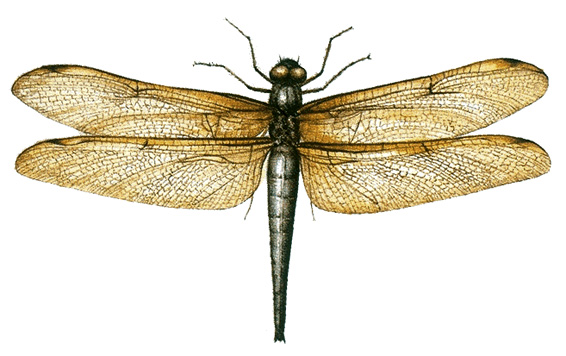Dragonfly is the name of a group of flying insects that have four large, fragile wings resembling fine gauze. These wings shimmer and gleam in the sunlight during flight. A dragonfly has a long, slender body. The body may be red, green, or blue, with white, yellow, or black markings. Large compound eyes, which look like beads, cover most of the head. The insect’s eyes enable it to see in different directions. A dragonfly has six legs covered with spines. It can use its legs to perch on a limb. However, the legs are not adapted for walking. As a dragonfly flies through the air, it holds its legs together to form a basket in which to capture insects. The dragonfly grabs hold of its prey with its legs or jaws. It may eat the prey while flying.

The largest modern dragonflies have wingspreads of about 7 1/2 inches (19 centimeters). However, many prehistoric dragonflies grew much larger. Some of these ancient insects had wingspreads of 28 inches (70 centimeters) or more.
Dragonflies fly up to about 38 miles (61 kilometers) an hour. They can make sharp, acrobatic turns in the air. Because of their excellent flying ability, the insects normally can escape from birds or other predators (hunting animals).
Male and female dragonflies often fly together. They sometimes mate while in flight. The female often deposits her eggs in the water or inside the stem of a water plant. The nymph (young dragonfly) usually hatches within one to three weeks. It has a thick body, big head and mouth, and no wings. It has a folding lower lip, called a mask, which is half as long as its body. The lip has jawlike hooks at the end and can move out to capture victims. The nymph breathes by means of gills.
A dragonfly nymph remains in the water for one to five years. It eats insects and small water animals. Some large dragonfly nymphs may feed on young fish. While developing into an adult dragonfly, a nymph molts (sheds its skin). Molting usually occurs 9 to 12 times. For its final molt, the nymph leaves the water and climbs onto a reed or rock. It then sheds its skin for the last time and emerges as an adult. The new adult soon can fly. Adult dragonflies live for only a few weeks to a few months.
Dragonflies are sometimes called devil’s-darning-needles, snake doctors, snake feeders, or horse stingers. They help people by feeding on mosquitoes and other harmful insects. Damselflies resemble dragonflies, but they have more slender, fragile bodies.
